Garden
Growing fruit trees
Care cropping
Trimming . You need the following types of pruning: after landing, forming, decimation and rejuvenating .
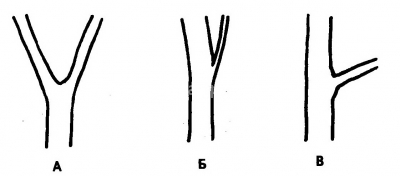
Fig. 140 . Examples of branches A and B - are weak, - - strongTrees with severely damaged roots and "tired" long carriage cut short, leaving 1/3 of the length of shoots . In seedlings with developed, not dried up and little damage to the roots, transplanted from a nearby nursery immediately after excavation and transportation, shoots can be shortened a bit, cutting off about half their length . Thispruning is carried out in the spring regardless of the period grafting .
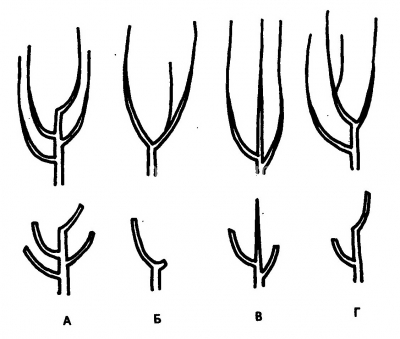 Fig. 141 . Pruning after planting: A - trees with the right crown, B, C, D - with defective crowns
Fig. 141 . Pruning after planting: A - trees with the right crown, B, C, D - with defective crownsAnnual treeAfter landing on the sixth cut the kidney, starting from the place where the crown will be formed . Often annual okulyanta have side shoots . As a rule, this ensures its rapid growth after planting . From the side shoots okulyanta annual leave only those which are necessary for the formation of the future crown .
By rounded crown are: natural crown,formed in accordance with the name without any particular scheme, and the crown, formed by strictly established models, such as free-tiered, boiler-shaped and spindle-shaped . At present, the gardens are increasingly common crown approaching in the section to have elongated rectangle . A number of trees with crowns of such formsrelatively flat trellis resembling a rare hedges .
Pretty hard pruning atthe formation of free-tiered crown is only slightly delay the entry of a tree during fruiting . But it allows you to create a powerful and beautiful crown, especially if left shoots reject that they form a large angle with the conductor .
Spindle-shaped crown is most popular in dwarf gardens of Western Europe . It is a miniature crown of old pear trees is not circumcised, has entered a period of full fruiting . Crohn's has a distinct and high conductor and a lot of relatively small branches locatedhorizontally .
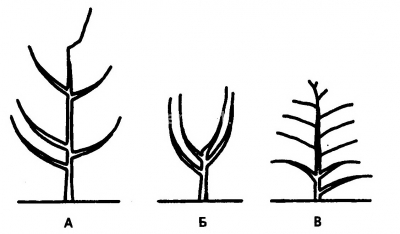 Fig. 142 . Rounded crown: A - free-tiered, B - boiler-shaped, V - fusiform
Fig. 142 . Rounded crown: A - free-tiered, B - boiler-shaped, V - fusiformFree tapestry is one of the easiest . Its formation begins withannual pruning okulyantov (A plant subjected to budding) at a height of 60 cm and a shortening of lateral shoots at a few of the kidneys . Then throughout the year the trees grow freely . In the spring of next year, part of the shoots growing in the direction of row spacing, cut out, and the remaining bends towards the row of trees, and in this position the peg towire between the supports. tapestries be formed without wires . In this case the branches are tied to hooks driven into the ground, or to trees . Shoots set not only in the planar direction of rows, they also give more oblique position, close to horizontal . The conductor is shortened by 1/3, so that it is covered by sideshoots . It is also possible to shorten the two top flight, so they are not dominated clipped conductor . Bottom shoots can not be shortened .
Care is not a regular trellispresents special difficulties . Trees into early fruiting period and give a very high yield, aided by good lighting conditions throughout the crown .
Lattice and trellis arch decoration are many French gardens . Once they recommended for the production of gardens, but theirformation proved to be too expensive . The creation of these tapestries based on the formation of strong shoots with a corresponding tilt conductor . We normally growing tree is the strongest shoots formed from the upper buds, with wood mood angle of 30 ° to the horizon - okulyanta near the bottom, and at arc bending - in its upper part .
Both tapestries come from France, where the conditions for tree growth particularly favorable . So you needexpect that in the Non-Chernozem zone, despite the most careful care, will not be able to get in one year so strong shoots to create one
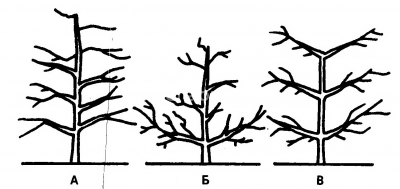
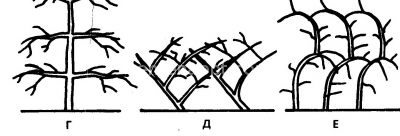 Fig. 143 . Scheme formation trellis crowns: A - free trellis, B - regular trellis, B - sloping regular palmette, G - regular horizontal palmette, D - lattice trellis (Bush, Tom) E - arched trellis (Lepage)
Fig. 143 . Scheme formation trellis crowns: A - free trellis, B - regular trellis, B - sloping regular palmette, G - regular horizontal palmette, D - lattice trellis (Bush, Tom) E - arched trellis (Lepage)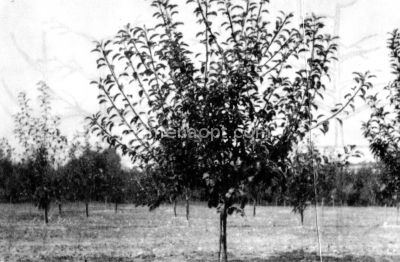 Fig. 144 . Young tree with almost natural crown has not cropped
Fig. 144 . Young tree with almost natural crown has not cropped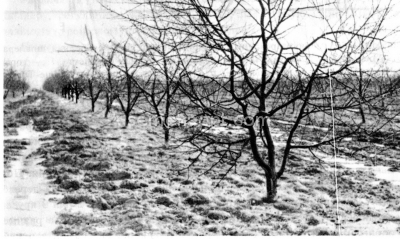 Fig. 145 . Apple with free-tiered crown
Fig. 145 . Apple with free-tiered crown Fig. 146 . Successive stages in the formation of free-tiered crown A, B, C (lines denote places pruning shoots)
Fig. 146 . Successive stages in the formation of free-tiered crown A, B, C (lines denote places pruning shoots)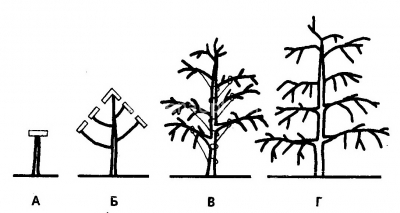 Fig. 147 . Formation of spindle crown: A - cropping spring yearlings, B - pruning trees for the second year in the spring, - slightly bending branches and tying them to the trunk of the summer, T - shaped spindle-shaped crown
Fig. 147 . Formation of spindle crown: A - cropping spring yearlings, B - pruning trees for the second year in the spring, - slightly bending branches and tying them to the trunk of the summer, T - shaped spindle-shaped crown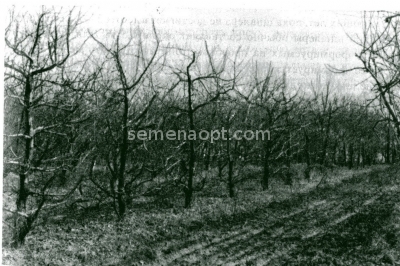 Fig. 148 . Formed as a free apple espalier
Fig. 148 . Formed as a free apple espalier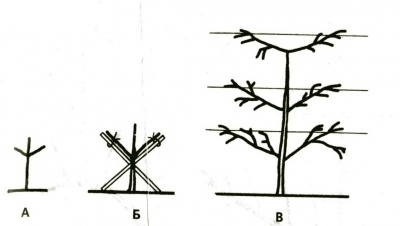 Figure . 149 . Formation of regular oblique palmettes: A - pruning yearlings, B - the formation of a two-year trees, B - fully formed palmette
Figure . 149 . Formation of regular oblique palmettes: A - pruning yearlings, B - the formation of a two-year trees, B - fully formed palmette Fig. 150 . Depending on the position of the strongest tree grows Escape: A - from its top, B - from the base, B - from the top of the arc formed by the bent sapling
Fig. 150 . Depending on the position of the strongest tree grows Escape: A - from its top, B - from the base, B - from the top of the arc formed by the bent sapling Fig. 151 . Start building a lattice trellis: A - getting strong shoots at the base of the planted seedlings of annuals, B - limb of the shoots in the neighboring trees
Fig. 151 . Start building a lattice trellis: A - getting strong shoots at the base of the planted seedlings of annuals, B - limb of the shoots in the neighboring trees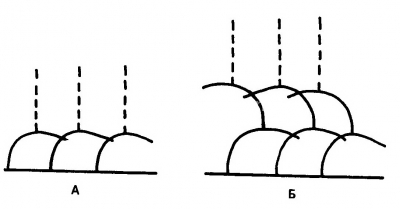 Fig. 152 . Successive stages of forming an arched trellis - A, B (dotted line - strong shoots before they are slightly bending)
Fig. 152 . Successive stages of forming an arched trellis - A, B (dotted line - strong shoots before they are slightly bending)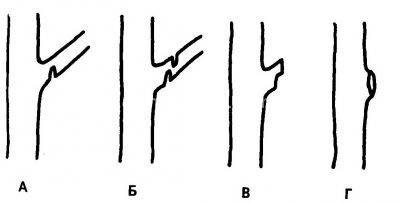 Fig. 153 . Successive stages of cutting thick branches of the way, its failure warning - A, B, C, D
Fig. 153 . Successive stages of cutting thick branches of the way, its failure warning - A, B, C, D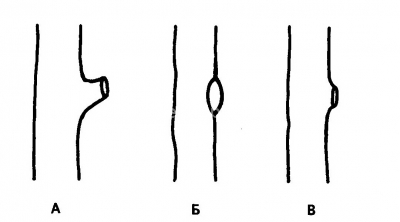 Fig. 154 . Trimming side shoots: A - too far from the main shoot, B - too close to the main stem, in - at the right distance ('on the ring')
Fig. 154 . Trimming side shoots: A - too far from the main shoot, B - too close to the main stem, in - at the right distance ('on the ring')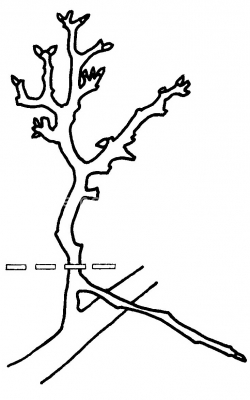 Fig. 155 . Thinning crown - remove fruit shoots over three years
Fig. 155 . Thinning crown - remove fruit shoots over three years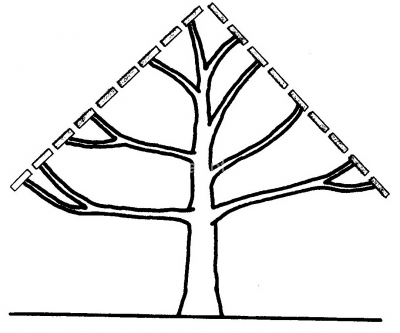 Fig. 156 . Rejuvenation of old fruit tree
Fig. 156 . Rejuvenation of old fruit tree


















